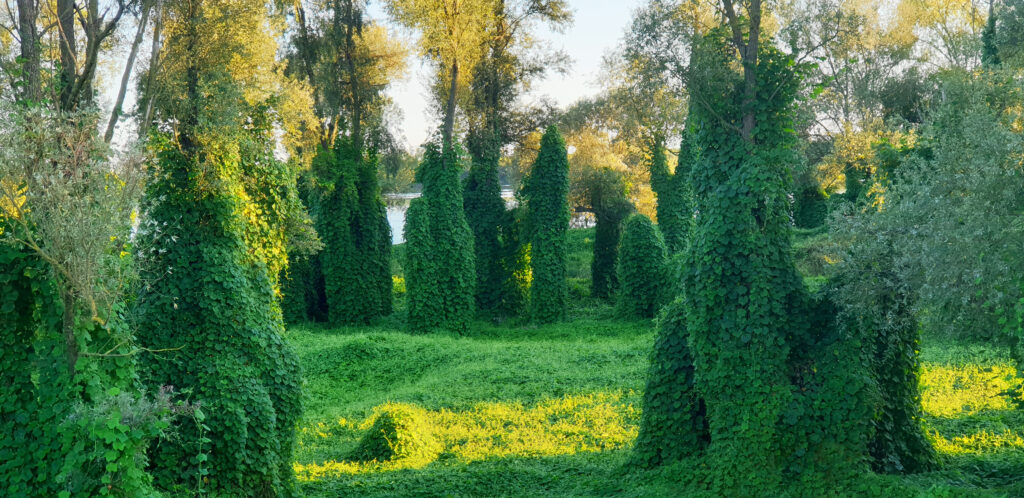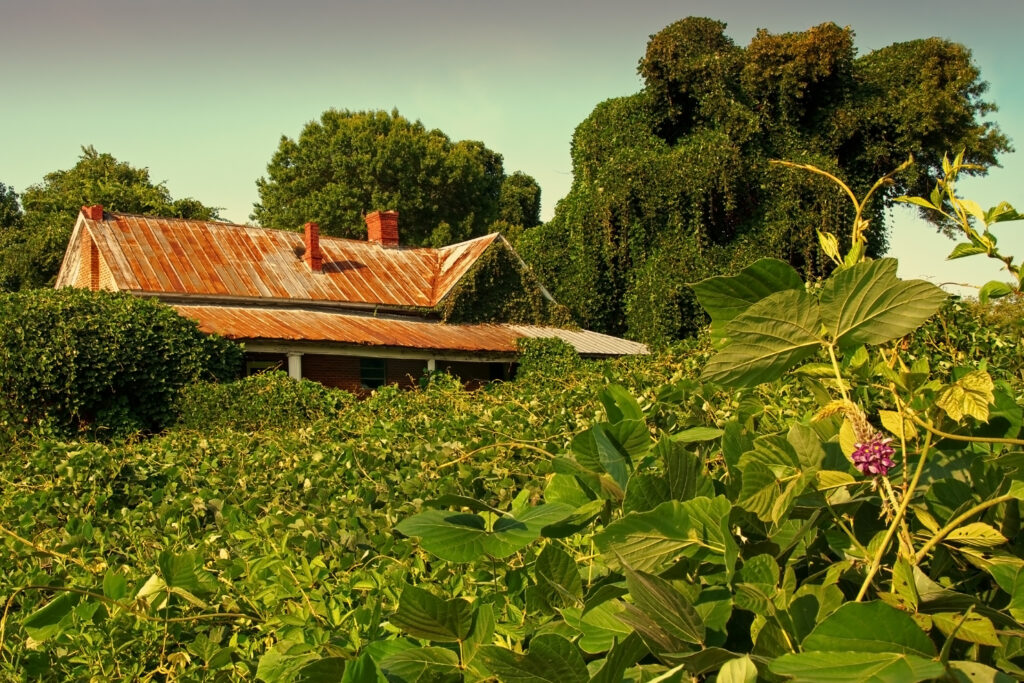Far Eastern vines
Run from the clay banks they are
Supposed to keep from eroding.
Up telephone poles,
Which rear, half out of leafage
As though they would shriek,
Like things smothered by their own
Green, mindless, unkillable ghosts.
In Georgia, the legend says
That you must close your windows
At night to keep it out of the house.
–from Kudzu by James Dickey
I grew up in rural Georgia, so I saw first hand how kudzu climbs up telephone poles, invades and conquers fields and strangles giant oaks. When I was in graduate school, ecology graduate students on the first floor of our building were searching madly for something, some bug, that would eat kudzu, in hopes that they might some day graduate.
So it was with great interest that I read the recently published paper by Hickman and colleagues describing in greater detail just how noxious a noxious weed Pueraria montana (kudzu) is.
Kudzu is a nitrogen-fixing legume, a class of plants that usually engenders thoughts of soybeans and crop rotation. However in the case of the highly invasive weed, Kudzu, the nitrogen fixing is a problem.
When legumes form associations with bacteria capable of “fixing” atmospheric nitrogen into ammonium (NH4+), the amount of nitrogen in the soil increases. In areas where an invasive nitrogen-fixing plants have completely taken over an entire woody area (yes, kudzu can completely cover and strangle acres of woods), suddenly all of this nitrogen in the soil becomes available for more microbial activity including the oxidation of ammonium to nitrate and the reduction of nitrate to nitrogen. As these sort of nitrogen transformations increase, emissions of NO and nitrous oxide (N2O) increase as well.

So, not only does invasion of Kudzu lead to a hiding ground for poisonous snakes that kill your cows [“For when the kudzu comes, the snakes do” (Dickey)], it increases green house gases that can in turn locally raise ozone levels. Additionally, kudzu releases isoprene, a hydrocarbon that is reactive in the presence of light and involved in ozone production.
To determine if invading kudzu does lead to locally increased emissions of NO emissions, the authors investigated soil chemistry and nutrient cycles in kudzu-free and kudzu-invaded fields in Madison County, GA. The authors saw increases in N mineralization rates in soil cores from kudzu-invaded fields compared to the uninvaded fields. Net rates of nitrification, the precursor to soil NO production, were anywhere from 110 to 532% higher in the kudzu-invaded fields. When emissions of nitrogen trace gases from soils were compared, emissions of NO were significantly higher from kudzu-invaded plots. N20 emissions were higher, but not statistically significant. Additionally kudzu-invaded sites had more inorganic nitrogen in July and September than uninvaded sites as well, although again the soil pools of ammonium were not significantly higher.
In their discussion, the authors say that this initial study needs to be expanded to be a longer-term study that covers a larger geographic area. In this way the authors hope to be able to assess the actual coverage of kudzu more accurately and get larger sample sizes for more robust statistics. However, the authors do state that “the unusual physiological combination of moderate to high emissions of isoprene and a high N-fixation capacity able to double soil NO fluxes in Georgia makes kudzu a unique source of key precursors to tropospheric ozone in the United States; it may be as close to a “polluting plant” as one can find.”
Like things smothered by their own green, mindless, unkillable ghosts
Hickman, J., Wu, S., Mickley, L., & Lerdau, M. (2010). Kudzu (Pueraria montana) invasion doubles emissions of nitric oxide and increases ozone pollution Proceedings of the National Academy of Sciences https://www.pnas.org/doi/full/10.1073/pnas.0912279107
Michele Arduengo
Latest posts by Michele Arduengo (see all)
- An Unexpected Role for RNA Methylation in Mitosis Leads to New Understanding of Neurodevelopmental Disorders - March 27, 2025
- Unlocking the Secrets of ADP-Ribosylation with Arg-C Ultra Protease, a Key Enzyme for Studying Ester-Linked Protein Modifications - November 13, 2024
- Exploring the Respiratory Virus Landscape: Pre-Pandemic Data and Pandemic Preparedness - October 29, 2024


It was my understanding that if left to make the choice, 10 out of 10 goats would go straight for the kudzu:
http://www.nytimes.com/wp-content/uploads/2007/06/05/us/05goats.htm
So there is a solution, but I have a hunch one must feel comfortable with a certain aesthetic for it to be successful.
What a great solution! Go goats!